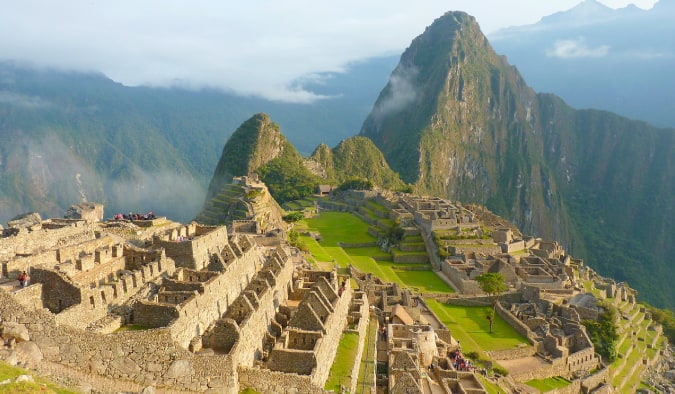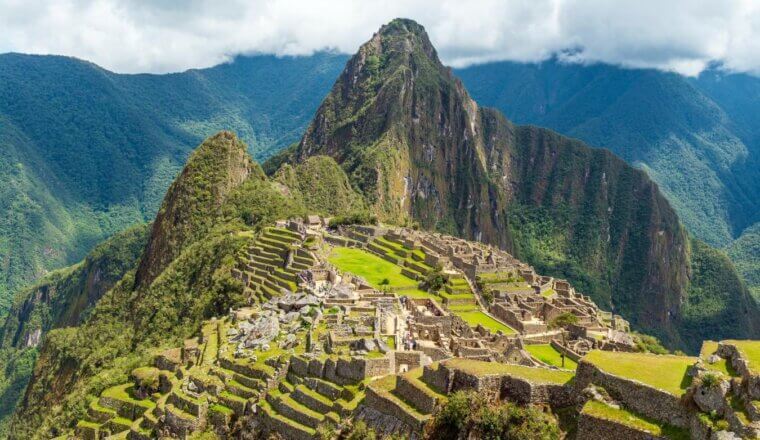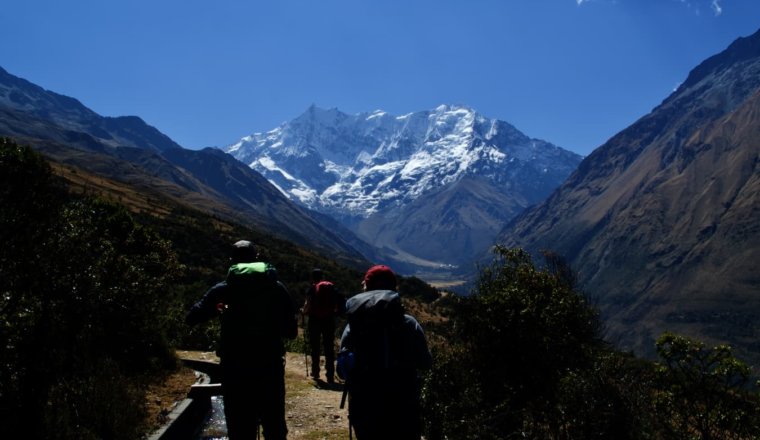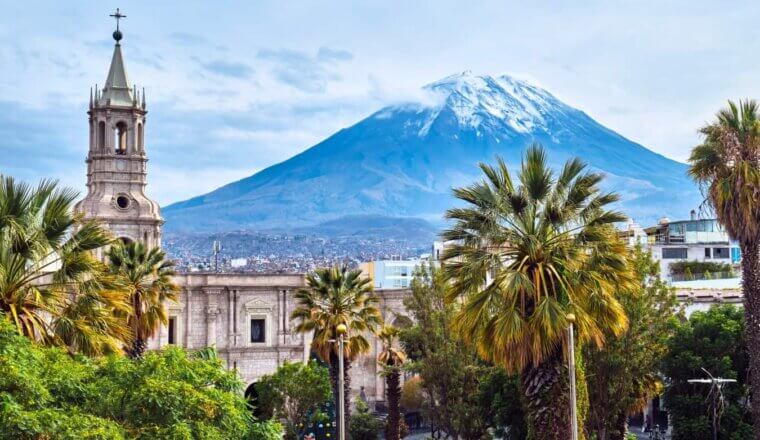
Posted: 10/29/15 | October 29th, 2015
Earlier this year, I read the book Turn Right at Machu Picchu by Mark Adams, about his quest to follow Hiram Bingham’s trail through Peru. It made me want to jump on a plane right then and there and gave me an insight to Peru I never knew before…and it gave a whole list of off the beaten path places to visit!
After I read his new book, Meet Me in Atlantis, I cold e-mailed Mark for an interview. He was hesitant at first, but I persisted and got to speak to him while he was in NYC! After fanboying out over his books and taking a few selfies, we got to the interview:
Nomadic Matt: Tell everybody about yourself. How did you get into travel writing?
Mark Adams: I grew up outside of Chicago and studied English in college. I went off to grad school thinking I was going to be an English professor, but after getting my master’s, I took a year off and tended bar. One night a friend of mine said she’d met the managing editor of Outside magazine and that she thought I should apply for their internship program.
Working for a magazine had never really occurred to me; it seemed like something people did in the movies. But I bought a copy of Outside, loved it, applied for the internship, and got it.
After six months at Outside, I went to New York and got a job fact-checking at GQ. The great thing about fact-checking was that you went from nothing to working with some of the best writers in America. And then you had to take apart their stories, line by line, and examine the basic elements that make up a great story. It’s a lot like diagramming sentences.
And then you get to eavesdrop on the conversation between the writer and his or her editor to see how they decide what’s working and what isn’t, how to “kill your darlings” as they say, and cut your prose to its essentials.
Nomadic Matt: How were you inspired to write your book Turn Right at Machu Picchu?
In 2009, I was working as an editor at National Geographic Adventure magazine and realized I was seeing pictures of Machu Picchu everywhere — on the cover of the magazine, in the office hallways, in the materials we sent out to potential advertisers.
At that time Machu Picchu had roughly the same status for travel magazines as pre-scandal Tiger Woods did for Golf Digest. You could put it on the cover again and again and again and people didn’t care. They’d buy it every time because it was on their wish list. Everyone wanted to go!
I’d just published my first book, Mr. America, which got wonderful reviews and sold about twelve copies. I realized the 100th anniversary of Machu Picchu’s rediscovery was coming in 2011 and thought, “If I could just pull my act together and get this book reported and written in about 15 months, an anniversary would be a great tie-in when it comes time to promote this thing.”
So I decided to retrace Hiram Bingham’s incredible 1911 Yale Peruvian Expedition on which he located the ruins of Machu Picchu.
Nomadic Matt: Your wife is Peruvian. Did that play a part in wanting to write about the story?
Yes, but what really got me excited about seeing all the various sites was going back and reading Hiram Bingham’s original story about how he’d been enchanted by the idea of searching for the lost city of the Incas, a place known only from the 16th-century chronicles of the Spanish conquistadors, a mysterious place called Vilcabamba.
The way Bingham told it—and Bingham was a great self-mythologizer—in 1911 he had departed from Cusco and, along the way, he stopped at a tiny riverside inn. The tavern owner there said, “You know, there are these interesting ruins up in the mountains if you want to check them out.” And Bingham supposedly was like, “No, no, I’ll get to them later.”
But Bingham goes up the next day and sees Machu Picchu completely overgrown by vegetation. Even with trees growing on top of the temples he could tell it was an incredible site. He takes measurements and drawings and stuff, and, crucially, snaps photographs to take back to America.
Bingham eventually did find the city that experts now consider to have been Vilcabamba, but it was a bug-infested, ugly pile of stone ruins down in the Amazon. Bingham thought, “this couldn’t possibly be the romantic lost city of the Incas I’ve read about. Instead, it had to be this sort of majestic city I saw on the mountaintop.”
He spent much of the rest of his career trying to prove that (incorrectly, as it turned out).
Nomadic Matt: So what made you then decide to turn right at Machu Picchu and see all these other sites?
It was Bingham’s 1911 expedition that did it for me. Back then was the golden age of exploration, when explorers were becoming famous by racing to the South Pole and filling in the last blank spots on the world map. Bingham desperately wanted a chunk of that trend.
Once I read his accounts and went through his papers at Yale, I knew that if the territory he’d traveled through was still anything like it had been back in 1911 that this was going to be a great trip.
The part of Peru he’d walked through was one of the most amazing and varied places on earth and aside from the modern Machu Picchu tourism apparatus, it had barely changed in the hundred years since he’d been there!
When I started to plan my own expedition, I realized there were no roads to most of these places. It’s days and days of walking, so just like Bingham I needed to hire mules, mule tenders, and a cook. Once I went down to Cusco and met my guide, John Leivers, I knew this trip had the foundation of a great story: it had characters, action, adventure, and, importantly, things that could go wrong.
Remember, at the start of the book I’d never slept in a tent before.
Nomadic Matt: Why do think everyone focuses on Machu Picchu and not all of these other sites?
Because Machu Picchu is so spectacular. It’s like stepping inside a natural cathedral. Not just the buildings themselves but their locations, the way they’re nested in this sort of cradle of surrounding mountains, and the way the Urubamba River wraps around Machu Picchu in a sort of omega shape. The way the fog disperses in the morning.
The Incas knew exactly what they were doing when they picked that spot. It’s got to be one of the most beautiful sites on earth.
Nomadic Matt: Are the other sites not like that?
They are very interesting, and some of them are in spectacular settings, but a place like the real Vilcabamba in the jungle is very hard to get to. Unlike Machu Picchu, there’s no hotel. Most of these places have nowhere to stay, no café or anything like that. It took us three days to get to Vilcabamba on foot. As John Leivers says in the book, that kind of travel has largely fallen out of fashion because people are, for better or for worse, into this sort of “Instagram travel” where we go someplace mostly to get an awesome picture and show it off for bragging rights.
Nomadic Matt: You know, as much as I live on the internet, there are some times I’m just like, “We don’t have to photograph every meal. Let’s just eat!” Could those other sites be built up?
They could be, and the Peruvian government is trying to figure it out. They’re talking about building a cable car up to the ruins of Choquequirao, which is known as Machu Picchu’s sister city. But a place like Choquequirao is still pretty far out. You have to hike down and up a canyon that’s akin to the Grand Canyon.
I think over time the other sites will become more popular. People are always looking for a less crowded experience. They’ll figure out the experience at Choquequirao is still like Machu Picchu was like 25 years ago. It’s still a very dirty, sweaty, bring-your-own-backpack-and-camping-gear kind of trip. It’s the sort of place you’ll see a lot of Germans with a lot of big backpacks, and in my experience, if you get someplace and see a lot of backpacking Germans, you’re probably someplace that hasn’t really been discovered yet.
Nomadic Matt: So let’s talk about your new book, Meet Me in Atlantis. How do you go from Machu Picchu to this?
While I was doing Machu Picchu I came across a story in the New York Times from 1911, a front-page story with the headline “German Discovers Atlantis in Africa.” It was about how some German explorer had gone to what I think was what we now call Zimbabwe, and used the clues that the philosopher Plato had written about in his Atlantis story to find what he thought was the original lost city.
Around the same time that I started thinking about Machu Picchu, I was working for National Geographic Adventure on the day that Google Earth came out. We started getting all of these excited emails from people saying, “I’ve found Atlantis!” They all thought it was this sort of grid pattern in the southern Caribbean; if you zoomed in, there was a little tic-tac-toe thing down there. It turned out to be signals from ships’ sonars or something like that, which Google later erased, leading to new conspiracy theories, as is often the case with Atlantis.
It made me realize that there were a lot of people out there who still think they can find Atlantis.
Around that time I was writing a magazine story about great philosophers and had to read a lot of Plato, who is the only source for the Atlantis tale. I realized there’s an awful lot of detail in this thing. There are descriptions of the city, buildings, distances, and names of places that may or may not be the same as similarly named places today, like when he mentions Gades, which is now Cádiz in Spain. The idea of searching for the truth became irresistible to me.
Nomadic Matt: Why do you think the Atlantis myth persists so much?
For starters, it is such a great story. As someone once said, it’s basically Star Wars in sandals. You have this evil empire, ruled by kings that used to be virtuous and became debased, and they go up against scrappy little Athens, and suddenly this indomitable force of Atlantis is overcome in a day and night by an earthquake and flood. This sophisticated island nation disappears from the face of the earth.
The other reason is that if Atlantis is real and somebody does find it, that’s like finding King Tut’s tomb times ten. You’ll instantly be one of the most famous explorers of all time. Your name will live forever.
Nomadic Matt: You also think it could be this idea that we were once better than ourselves?
Nostalgia for a great lost golden age runs deep. It might even be in our wiring because it’s so common. Everything from the Garden of Eden to Shangri-la is a sort of human longing to go back to that original lost place.
Another important thing to remember is that Plato was writing about Atlantis when written history was a new technology. For more than 2,000 years everyone assumed that The Odyssey and The Iliad were made up stories, but now many experts believe that they were based on real events.
So the question is, how much of the Atlantis story that Plato tells did he intend to be fictional and how much of it did he intend to be taken at face value?
He may be telling stories for purposes we don’t fully understand. The Atlantis story, at least the first part, comes at the beginning of the work called Timaeus, which is Plato’s attempt to explain the nature of the cosmos, to explain how the universe worked, arguably the most important topic that could possibly be discussed.
A lot of eminent historians and archaeologists insist that Plato invented Atlantis completely, but the explanation that the most important philosopher of all time would just make up this elaborate story about a sunken city and stick it at the beginning of what may have been his most ambitious work strikes me, at the very least, as a little weird.
Nomadic Matt: Since people can’t go to Atlantis like they can Machu Picchu, this book is much less a travel book than the other. What do you want people to take away from this story?
Well, that raises the question of what a travel book is. Hemingway’s novels in Spain? In Patagonia? A Rick Steves book? The Viking Cruises catalog? The thing I always tell people when they ask me how I became a travel writer is that I never became a travel writer — I just became a writer, or to use a term that is overused these days, a storyteller. Everything I write is a nonfiction story with plot development and characters that change in some way during the events conveyed; many of those stories just happen to take place in interesting locales.
There are actually more travel details in the Atlantis book in terms of airports and hotels and restaurants than in the Machu Picchu book, but the thing I want readers to take away from Meet Me in Atlantis is the same thing I hope they take away from anything I write: I want to temporarily immerse them in another world, to make them think “wow, I had no idea.”
Nomadic Matt: Touche! What are your three pieces of advice for all the travelers out there?
I would say:
- Learn to pack better. I traveled to six countries over five weeks while reporting the Atlantis book and thought I was doing pretty well. Then I went to Madagascar with some guys who were serious ultra-endurance types who specialize in minimizing their loads, including one guy who was an ex-Army Ranger whose pack was like Santa Claus’s bag of toys—he had everything in there. And it made me realize that I was still overpacking. Now I go with a large daypack, period, and it simplifies everything.
- Put your phone down and talk to someone. If you’re traveling just for photo ops, you’re better off going to a Sears Portrait Studio and using their prop backgrounds. You’ll save a lot of money and everyone you went to high school will be impressed. “Wow, when did you go to the moon?” I think there are parts of your brain that only open when you travel, and if you spend all your time trying to document your own awesomeness, you completely miss a rare opportunity to explore new regions within your own mind.
- Buy a good fleece jacket. Tuck the body into one arm to make a pillow. Get a window seat on your long flight. Sleep.
Turn Right at Machu Picchu was one of my travel books of the year and, as an Atlantis myth lover, I enjoyed that book too. My grandmother was very into Atlantis, Ancient Aliens, crystal skulls, and the like so when I was younger she would always talk about them with me. Having grown up with an intense fascination with this stuff, I found the science and research behind proving/disproving the myth fascinating (my take: I think Atlantis existed as an advanced society by contemporary standards in Spain). Mark is a captivating writer and both his books were delights to read. Next year, I’m heading to Peru and plan to visit some of the off the beaten path Inca sites mentioned in his book. Time to put on my own Indiana Jones hat!
Book Your Trip: Logistical Tips and Tricks
Book Your Flight
Find a cheap flight by using Skyscanner. It’s my favorite search engine because it searches websites and airlines around the globe so you always know no stone is being left unturned.
Book Your Accommodation
You can book your hostel with Hostelworld. If you want to stay somewhere other than a hostel, use Booking.com as it consistently returns the cheapest rates for guesthouses and hotels.
Don’t Forget Travel Insurance
Travel insurance will protect you against illness, injury, theft, and cancellations. It’s comprehensive protection in case anything goes wrong. I never go on a trip without it as I’ve had to use it many times in the past. My favorite companies that offer the best service and value are:
- SafetyWing (best for everyone)
- Insure My Trip (for those 70 and over)
- Medjet (for additional evacuation coverage)
Want to Travel for Free?
Travel credit cards allow you to earn points that can be redeemed for free flights and accommodation — all without any extra spending. Check out my guide to picking the right card and my current favorites to get started and see the latest best deals.
Need Help Finding Activities for Your Trip?
Get Your Guide is a huge online marketplace where you can find cool walking tours, fun excursions, skip-the-line tickets, private guides, and more.
Ready to Book Your Trip?
Check out my resource page for the best companies to use when you travel. I list all the ones I use when I travel. They are the best in class and you can’t go wrong using them on your trip.


